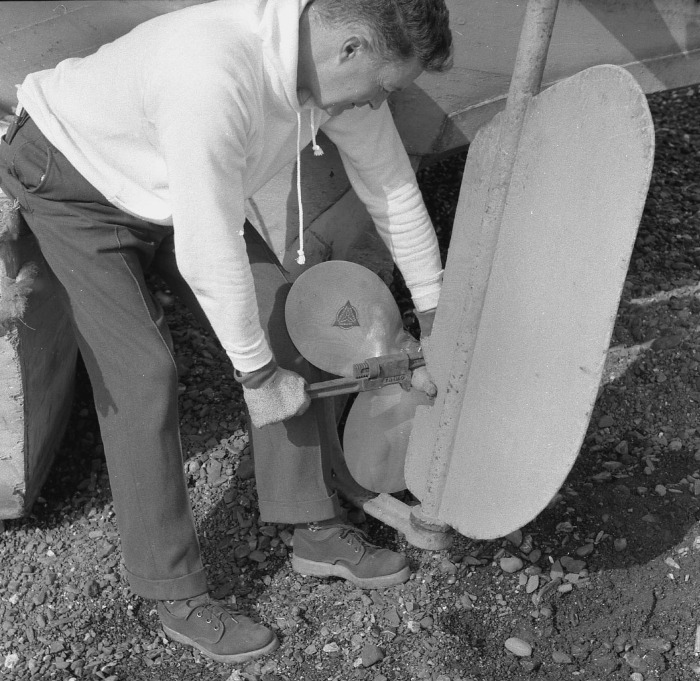Rudder — ARulaq
Anguamek aRulallrianga.—I used a paddle as a rudder (to steer).

Photo: Norman Smith works on the prop of the Evangel, Larsen Bay, ca. 1955. Courtesy of Tim and Norman Smith
There are many types of rudders found in boat designs around the world and they are all important parts of a boat’s steering system. A rudder is often a vertical blade attached to a boat’s transom, the flat end of the stern. The rudder rests under water and it is controlled from the helm. When a driver turns a boat’s rudder it pushes water to one side. The force created helps to turn the boat’s bow in the same direction.
Rudders were not among the parts of Alutiiq boats. Kayaks and angyat (open skin boats) had a flat ended stern, or keel, but no moveable rudder. These lightweight boats were steered by their users. Paddles acted as rudders, moving skin boats in the desired direction. In a two-person or three-person kayak, the paddler in the stern acted as the steerer, reaching back with a paddle to push the boat to the right or the left. Similarly, Elders recall using an oar as a rudder when traveling in a skiff.
The concept of a rudder appears to have been introduced to Kodiak by Russian sailors. The Alutiiq word for rudder comes from a Russian term. The Alutiiq verb to steer, alular-, is also derived from this term and appears in many other words related to boating. For example, the Alutiiq word for a steering wheel or the steering arm of an outboard motor is arusuun. The pilot house on a fishing boat is known as the alularwik–place to steer, and the stern man in a kayak is known as arusta–the steerer.
Rudders were not among the parts of Alutiiq boats. Kayaks and angyat (open skin boats) had a flat ended stern, or keel, but no moveable rudder. These lightweight boats were steered by their users. Paddles acted as rudders, moving skin boats in the desired direction. In a two-person or three-person kayak, the paddler in the stern acted as the steerer, reaching back with a paddle to push the boat to the right or the left. Similarly, Elders recall using an oar as a rudder when traveling in a skiff.
The concept of a rudder appears to have been introduced to Kodiak by Russian sailors. The Alutiiq word for rudder comes from a Russian term. The Alutiiq verb to steer, alular-, is also derived from this term and appears in many other words related to boating. For example, the Alutiiq word for a steering wheel or the steering arm of an outboard motor is arusuun. The pilot house on a fishing boat is known as the alularwik–place to steer, and the stern man in a kayak is known as arusta–the steerer.
